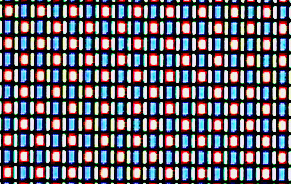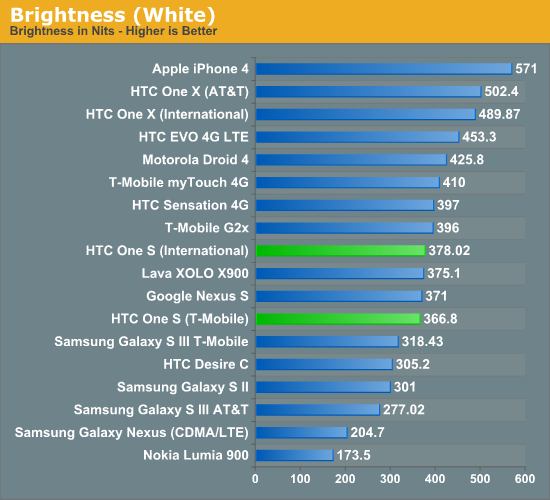HTC One S Review - International and T-Mobile
by Brian Klug on July 17, 2012 9:30 AM ESTThe One S display is a 4.3" SAMOLED panel with qHD (960 x 540) resolution. If that sounds really familiar, it’s because it’s the same as what was in the Motorola Droid RAZR series, including PenTile RGBG.

What’s different, however, is how well HTC has controlled the color temperature and gamma compared to Motorola in the RAZR. As shown in the HCFR galleries below, gamma is pretty close to 2.2 until you get to the high end, and color temperature is pretty close to 6500K, except at the two darkest grey points. This is so much better than any other OEM calibration of an AMOLED panel I’ve taken a look at, which is rather humorous because the panel is undoubtably Samsung’s. HTC is also letting the panel go pretty bright, up past 350 nits, instead of clamping it way down around 200 (I’m looking at you, Galaxy Nexus) to save power. I also haven’t noticed blacks not being totally off on the One S like I have with some others. Of course, colors are still massively oversaturated if your source color space is sRGB.

I’ve griped about PenTile RGBG before on this panel and other SAMOLED displays, but I find the One S to be completely enjoyable in spite of having it thanks to two things. First, how well HTC has controlled the panel (no awful hues, weird white points, or dramatic shifts as you change brightness) - this is basically the best I’ve seen this particular panel, and until SGS3, the best I’ve seen AMOLED in general. Second, because HTC doesn’t appear to be applying any processing that applies sharpening (like Samsung’s mDNIe) to text.
How you feel about PenTile really is the final factor: it’s there, but I’ve slowly become accustomed to it after staring at it for so long. If you go back to the Nexus S days, I was one of the most outspoken critics because of how large those subpixels were. With small enough subpixels (below visual acuity), PenTile starts to make sense. In other news, HTC moving back to Samsung AMOLED for phones is an interesting move after supply issues forced HTC to SLCD with some earlier phones, here on the HTC One S however, it looks great.






















97 Comments
View All Comments
ltcommanderdata - Tuesday, July 17, 2012 - link
To go with the smallest screen size for a modern smartphone, the iPhone 4S also has the smallest battery as shown on the first chart on page 2. It'd be interesting o find out how display power consumption scales with screen size to see if they are scaling battery size fast enough to fully compensate, but big phones with big screens do tend to have big batteries so big screens shouldn't automatically mean bad battery life.Penti - Tuesday, July 17, 2012 - link
4S doesn't have HSPA+ baseband only 14.0 Cat 10 HSDPA. I.e. 14Mbit "4G-branding". In short small batteries, large screens, fast processors and gpus and power hungry baseband is what drains these devices. You need a significant larger battery to have a better battery life here. For most devices that isn't a priority. For example the iPad 3 gen has a larger battery then MBAir 11.amdwilliam1985 - Tuesday, July 17, 2012 - link
Please explain the 4G part to a friend of mine.She claims her 4G iPhone 4s with iOS 5.1.1 on AT&T network can't go through a day with moderate usage.
Penti - Tuesday, July 17, 2012 - link
What, it's just a 3G WCDMA baseband, no other radio or tech it shouldn't draw more power just because the icon says 4G in this 3.75G device. No smartphone survives more then a day with moderate usage, calls and what not. An 4s is spec'd at 8 hours talk time and 6 hours of internet use over 3G respectively. Play a game and the device is pretty much dead half day. Using apps that pull data over the wireless cellular network, talk for a few hours and play a game for 15 minutes and it should be pretty drained. If there is nothing wrong with the device then it is the usage that has to change to accommodate more battery life. If you need to talk for hours a day and be connected to chat, surf the web, use apps that leverage the internet and all that over the network you would need some solution to charge the phone over the day not matter what device you run.Why some people whine about early LTE phones is because they had bad dual baseband chips and about half the talk time. Pretty bad battery life surfing on LTE etc.
Spoelie - Tuesday, July 17, 2012 - link
I'm wondering if the battery tests have ever been redone following iOS updates. In my experience, the battery life gets progressively worse with every new update. In this case, doing the tests once on release day and reusing the numbers for months on end may not be the best approach.Anand Lal Shimpi - Tuesday, July 17, 2012 - link
I'll take the blame for this one. Notice the revamp of our tablet and OS X battery life tests? The smartphone web browsing test is in need of an update there as well. iOS has gotten a little too "good" at what we're doing there, at least in the web browsing test. The call and tethering tests are still great cross-platform indications of battery life.rd_nest - Tuesday, July 17, 2012 - link
I think we should also look at multimedia playback times. Run high profile video files to check battery rundown time. It's an important parameter as far mobile usage is concerned.The SGS3 (International) is getting pretty good numbers compared to US SGS3 models.
yvizel - Tuesday, July 17, 2012 - link
Saying 3.5'' vs. 4.3'' is not an accurate argument.If you come to think of it, the iphone is a smaller device, therefore packs a smaller battery (as you can see in the Battery Capacity chart).
Also, I would rather have a "slower" processor and more battery juice than have an octa-core @ 4GHz on a smartphone with 1 hour of usage!
Not all of us use smartphone for gaming or whatever. I guess that the more common usage is web, email, GPS and other basic stuff. So again, no need for zillion cores on a smartphone.
Oh, and great review! looks like a great device!
Connoisseur - Tuesday, July 17, 2012 - link
My point is that it's extremely difficult to compare phones of different size, resolution, screen type, OS and capacity. Even if you remove the OS out of the mix (so you can compare OS "efficiency"), the only comparison you can really make between two different devices is hours/battery capacity efficiency.At least when comparing laptops, you have some basis for comparison (comparable hardware or form factor for example).
amdwilliam1985 - Tuesday, July 17, 2012 - link
We can do the following 2 tests.1) Hack and put iOS on an Android device and run the same test against iPhone 4s.
2) Hack both device and put a custom OS on both and run the test.
This way we can see if it's software or hardware that's affecting the battery life.